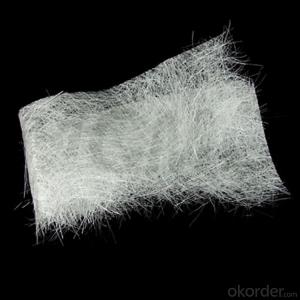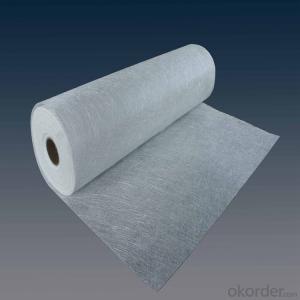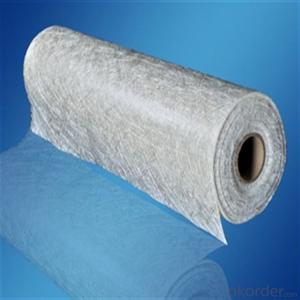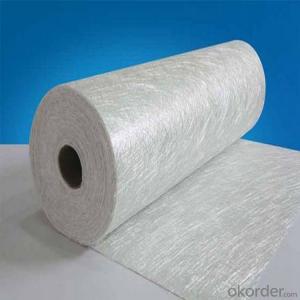High Tempreture Resistant E-glass Chopped Strand Mat for Insulation
- Loading Port:
- China main port
- Payment Terms:
- TT OR LC
- Min Order Qty:
- 1 kg
- Supply Capability:
- 5000 kg/month
OKorder Service Pledge
OKorder Financial Service
You Might Also Like
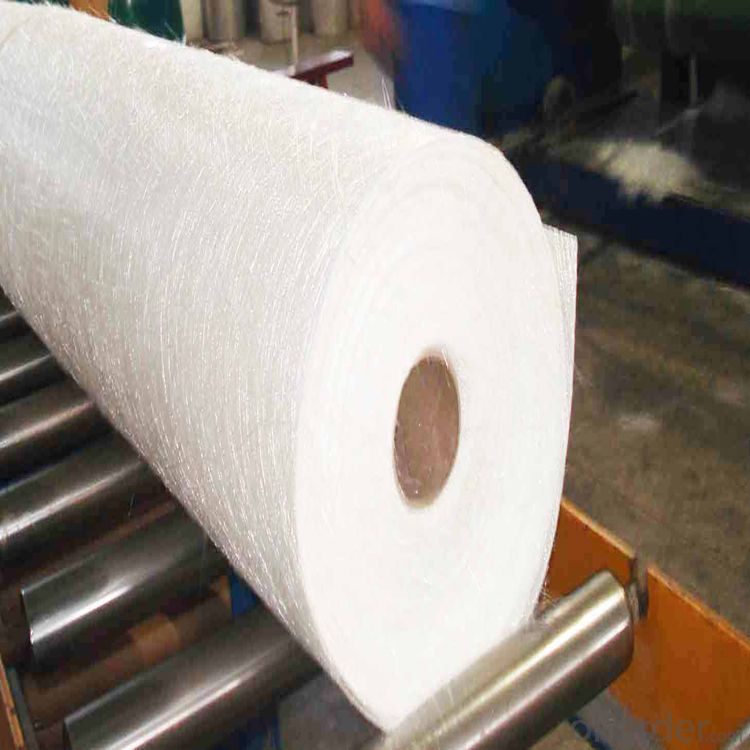
Product Description:
Fiberglass Chopped Strand Mat is fine strand reinforcement material made from E-glass cut fibers laid in a random pattern and bonded with powder or emulsion binder.
It is easy to handle and has excellent moulding performance.
Also, it has rapid resin penetration together with a fast strand wet out time.
The mat also brings a highly translucent finished laminates.
Also,the fine strand input makes the fiber prominence at the finished laminates surface extremely low.
Features
1.Excellent weight uniformity
2.Fast wet out
3.Easy air release
4.Excellent transparency of finished products
5.Excellent laminate
6.Low resin consumption
Application
1.Translucent roof panel
2.chemical storage tanks
3.FRP pipes
4.Boat hulls
5.Decks
6.Truck body panel
7.Cooling towers
8.Corrosion resistand
Specifications:
Item | Over Density | Moisture Content | Chop Density | Polyester Yarn | Width |
(g/m2) | (%) | (g/m2) | (g/m2) | (mm) | |
EMK300 | 309.5 | ≤0.15 | 300 | 9.5 | 50-3300 |
EMK380 | 399 | 380 | 19 | ||
EMK450 | 459.5 | 450 | 9.5 | ||
EMK450 | 469 | 450 | 19 | ||
EMC0020 | 620.9 | 601.9 | 19 | ||
EMC0030 | 909.5 | 900 | 9.5 |
Special products are available according to customer’s requirement.
Product Packaging:
Each Surface Tissue is wound onto a paper tube which has an inside diameter of 76mm and the mat roll has a diameter of 330mm. The mat roll is wrapped up with plastic film,and then packed in a cardboard box or wrapped up with kraft paper. The rolls can be vertically or horizontally placed. For transportation, the rolls can be loaded into a cantainer directly or on pallets.
Quantity
20'GP Container:About 10000kgs
40'HP Container:Aboout 23100kgs
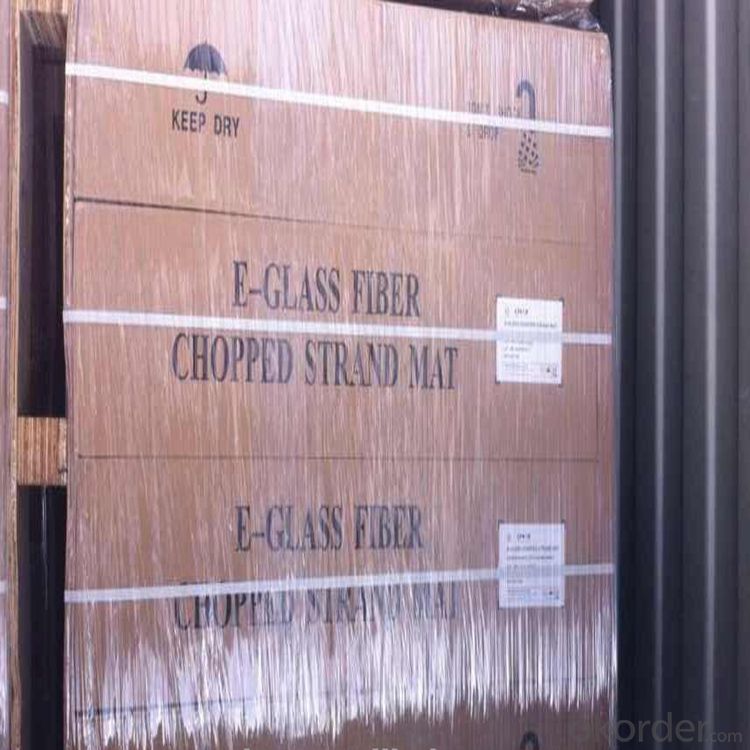
Product Storage:
Unless otherwise specified, Chopped Strand Mat should be stored in a dry, cool and rain-proof area. It is recommended that the room temperature and humidity should be always maintained at 15℃~35℃ and 50%~75% respectively.
Company Information
CNBM (China National Building Material) Group is the largest comprehensive building materials group in China that in integrate scientific research, manufacturing and logistics into one entity. The largest building materials and equipment specialists in China. Upon State Council approval, today CNBM owned more than 300 subordinate manufacturing factories and servicing companies. There are 6 fully owned public listed companies and 11 partially owned with substantial shares public listed companies. In many of these fields, CNBM is playing the leading role in the building industry in the country.

Our Service:
1.Any inquiry will be replied within 24 hours.
2.Professional manufacturer.
1) Print logo in the products;
2) The size and specification can be produce and design according to your demand.
3.High quality,fashion designs,reasonable and competitive price,fast lead time.
4.After-sale service
1) All products will have been strictly quality check in house before packing.
2) All products will be well packed before shipping.
3) All our products have 10 years rot resistance.
5.Faster delivery:sample order in stock,and 15-20 days for bulk production.
6.Payment:you can pay for the order via:T/T,Western Union,MoneyGram,L/C etc.
FAQ:
which kind of glass fiber sample and materials can you provide?
We can provide the glass fiber and glass fiber down stream products samples of E glass, C glass, ECR glass, High alkali glass. The products includes single end roving, assembled roving for different applications( Piping, SMC, panel, winding mill plate) , chop strand for BMC, engineering plastic (PA, PPA, PPT, POM, etc), chop strand mat (from 100gsm-900gsm) for automobile and water tank, etc, woven roving (270gsm-800gsm), surface tissue (25-50gsm), multi-axial fabric of different unit weight.
- Q:What are the typical moisture resistance properties of chopped strand composites?
- Chopped strand composites typically have good moisture resistance properties. The chopped strand reinforcement, usually made of glass or carbon fibers, is inherently resistant to moisture absorption. This resistance is further enhanced by the matrix material, which can be a thermoset resin like epoxy or a thermoplastic resin like polypropylene. The matrix material in chopped strand composites acts as a barrier, preventing water molecules from reaching the fibers. This barrier effect is especially pronounced in thermoset resins, which cure into a rigid and impermeable structure. Thermoplastic resins also provide moisture resistance, although to a slightly lesser extent due to their semi-crystalline nature. The moisture resistance properties of chopped strand composites make them suitable for various applications in wet or humid environments. For example, they are commonly used in marine applications, such as boat hulls and decks, where exposure to water is constant. They are also used in automotive components, aerospace structures, and infrastructure applications where moisture resistance is critical for long-term durability. However, it is important to note that while chopped strand composites have good moisture resistance, they are not completely impervious to water. Prolonged exposure to moisture or immersion in water can eventually lead to some degree of water absorption. Therefore, proper design considerations, such as the use of appropriate surface coatings or moisture barriers, should be taken into account to maximize the moisture resistance properties of chopped strand composites.
- Q:Is fiberglass chopped strand suitable for wind turbine blades?
- Yes, fiberglass chopped strand is suitable for wind turbine blades. It offers excellent strength-to-weight ratio, high stiffness, and good fatigue resistance, making it an ideal material for constructing durable and efficient wind turbine blades. Additionally, its corrosion resistance properties make it well-suited for withstanding the harsh outdoor conditions typically encountered in wind energy applications.
- Q:Can fiberglass chopped strand be used in the production of construction panels?
- Yes, fiberglass chopped strand can be used in the production of construction panels. Fiberglass chopped strand is a type of reinforcement material made from short lengths (strands) of glass fibers that are randomly oriented and bound together with a binder. These strands can be mixed with various resins, such as polyester or epoxy, to create a composite material that is strong, lightweight, and resistant to various environmental factors. In the production of construction panels, fiberglass chopped strand can be used as a reinforcement material to enhance the structural integrity and durability of the panels. The strands are typically added to the resin mixture and then molded into the desired shape, such as flat panels, sheets, or panels with specific profiles. The addition of fiberglass chopped strand helps to improve the strength and stiffness of the construction panels, making them more resistant to bending and cracking. It also provides better impact resistance and dimensional stability, ensuring that the panels can withstand various loads and environmental conditions. Furthermore, fiberglass chopped strand can also enhance the fire resistance and thermal insulation properties of the construction panels. The glass fibers in the chopped strand act as a barrier against heat transfer, reducing the risk of fire spreading and improving energy efficiency. Overall, the use of fiberglass chopped strand in the production of construction panels offers numerous benefits, including increased strength, durability, fire resistance, and thermal insulation. Hence, it is a suitable material choice for manufacturing construction panels.
- Q:Can fiberglass chopped strand be used in automotive interior components?
- Yes, fiberglass chopped strand can be used in automotive interior components. It is commonly used to reinforce various interior parts such as door panels, dashboard, and seat backs, providing enhanced strength and durability.
- Q:How is the dimensional stability of fiberglass chopped strand composites determined?
- The dimensional stability of fiberglass chopped strand composites is determined through various testing methods and evaluations. One commonly used method is the coefficient of thermal expansion (CTE) test. This test measures the change in dimensions of the composite material as it is subjected to different temperature variations. Another method is the moisture absorption test, which evaluates the extent to which the composite material absorbs and retains moisture over time. Moisture absorption can cause dimensional changes in the material, so this test helps determine the stability of the composite in humid or wet environments. Additionally, the creep test is conducted to assess the composite's resistance to deformation under continuous load over an extended period. This test measures the dimensional changes that occur over time when the composite is subjected to a constant stress. Furthermore, dimensional stability can also be determined by assessing the mechanical properties of the composite, such as tensile strength, flexural strength, and impact resistance. These properties indirectly indicate how the material will behave under stress and help evaluate its dimensional stability. Overall, a combination of these tests and evaluations helps determine the dimensional stability of fiberglass chopped strand composites and ensures their suitability for various applications.
- Q:What are the typical quality control measures for fiberglass chopped strand composites?
- When it comes to fiberglass chopped strand composites, there are several typical quality control measures that are commonly employed to ensure the integrity and consistency of the final product. 1. Raw Material Inspection: The first step in quality control is to inspect the raw materials used in the production of fiberglass chopped strand composites. This includes checking the quality and specifications of the glass fibers, resins, and other additives to ensure they meet the required standards. 2. Process Control: Quality control measures are implemented throughout the manufacturing process to monitor and control various parameters such as temperature, pressure, and resin-to-fiber ratio. This helps to ensure that the manufacturing process is consistent and that the final product meets the required specifications. 3. Fiber Length and Distribution: The length and distribution of the chopped fibers play a crucial role in the mechanical properties of the composite. Quality control measures are employed to measure and monitor the fiber length and distribution to ensure they meet the specified requirements. 4. Composite Thickness and Density: The thickness and density of the fiberglass chopped strand composites are important factors that affect their performance. Quality control measures are implemented to measure and monitor the thickness and density of the composites to ensure they meet the required standards. 5. Mechanical Testing: Various mechanical tests are conducted on the fiberglass chopped strand composites to assess their strength, stiffness, and other mechanical properties. These tests include tensile strength, flexural strength, impact resistance, and fatigue testing. Quality control measures ensure that these tests are conducted accurately and consistently. 6. Visual Inspection: Visual inspection is an important quality control measure for fiberglass chopped strand composites. Trained inspectors visually examine the composites for any defects, such as voids, delamination, or surface imperfections, and ensure they meet the required cosmetic standards. 7. Dimensional Control: Quality control measures are implemented to measure and monitor the dimensions of the fiberglass chopped strand composites, such as length, width, and thickness, to ensure they are within the specified tolerances. 8. Packaging and Labeling: Quality control measures are also applied to the packaging and labeling of the fiberglass chopped strand composites. Inspections are conducted to ensure that the packaging is intact and protects the composites during transportation, and that the labeling accurately reflects the product specifications. Overall, these quality control measures help to ensure that fiberglass chopped strand composites meet the required standards for strength, durability, dimensional accuracy, and appearance. By implementing these measures, manufacturers can deliver high-quality products to their customers and maintain their reputation in the market.
- Q:What are the typical curing conditions for fiberglass chopped strand composites?
- The typical curing conditions for fiberglass chopped strand composites involve subjecting the materials to a specific temperature and duration. The curing temperature typically ranges between 100-150 degrees Celsius, with a curing time of around 30-60 minutes. These conditions ensure the proper bonding and hardening of the composite materials, resulting in their desired mechanical properties.
- Q:How does the diameter of chopped strand affect its performance?
- The diameter of chopped strand affects its performance by influencing its strength, flexibility, and ability to bond with other materials. A smaller diameter strand tends to be stronger and more flexible, allowing it to withstand higher levels of stress and strain. It also provides better adhesion and compatibility with resin matrices, resulting in improved composite properties such as enhanced stiffness and impact resistance. Conversely, larger diameter strands may offer higher bulk density and improved thermal conductivity, but they can be less flexible and have reduced bonding capabilities. Therefore, the diameter of chopped strand plays a crucial role in determining the overall performance and properties of the final composite product.
- Q:What are the typical creep properties of fiberglass chopped strand composites?
- The typical creep properties of fiberglass chopped strand composites refer to the material's tendency to deform and relax under a constant load or stress over an extended period of time. Fiberglass chopped strand composites exhibit relatively low creep compared to other materials such as metals or polymers. This is due to the reinforcing properties of the fiberglass strands, which provide strength and stiffness to the composite. Creep in fiberglass chopped strand composites is influenced by various factors, including temperature, humidity, and the applied load. At higher temperatures, the creep rate tends to increase as the matrix material softens, allowing for more deformation. Similarly, high humidity levels can accelerate creep as moisture can weaken the matrix and reduce the overall strength of the composite. The applied load or stress level also affects the creep behavior of fiberglass chopped strand composites. Higher loads typically lead to higher creep rates, as the material experiences greater deformation under the sustained stress. However, the reinforcing nature of the fiberglass strands helps mitigate creep by distributing the load and preventing localized deformations. Overall, fiberglass chopped strand composites exhibit relatively low creep properties, making them suitable for applications that require dimensional stability and resistance to prolonged stress. However, it is important to consider the specific environmental conditions and load requirements to ensure the material's performance meets the desired expectations.
- Q:Can fiberglass chopped strand be used in electrical insulation applications?
- Indeed, fiberglass chopped strand finds utility in electrical insulation applications. Possessing non-conductive attributes and exceptional dielectric properties, fiberglass proves itself suitable for electrical insulation purposes. In the production of electrical insulation composites, chopped strand mat derived from fiberglass chopped strands serves as a prevalent reinforcement material. It bolsters mechanical strength and enhances electrical insulation properties, including insulation resistance and dielectric strength. Moreover, fiberglass chopped strand can also act as a filler substance in electrical insulation coatings and tapes, thereby amplifying their insulation capabilities.
1. Manufacturer Overview |
|
|---|---|
| Location | |
| Year Established | |
| Annual Output Value | |
| Main Markets | |
| Company Certifications | |
2. Manufacturer Certificates |
|
|---|---|
| a) Certification Name | |
| Range | |
| Reference | |
| Validity Period | |
3. Manufacturer Capability |
|
|---|---|
| a)Trade Capacity | |
| Nearest Port | |
| Export Percentage | |
| No.of Employees in Trade Department | |
| Language Spoken: | |
| b)Factory Information | |
| Factory Size: | |
| No. of Production Lines | |
| Contract Manufacturing | |
| Product Price Range | |
Send your message to us
High Tempreture Resistant E-glass Chopped Strand Mat for Insulation
- Loading Port:
- China main port
- Payment Terms:
- TT OR LC
- Min Order Qty:
- 1 kg
- Supply Capability:
- 5000 kg/month
OKorder Service Pledge
OKorder Financial Service
Similar products
New products
Hot products
Related keywords
